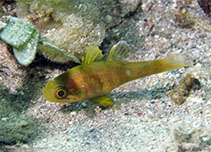| Family: |
Apogonidae (Cardinalfishes), subfamily: Apogoninae |
| Max. size: |
9 cm TL (male/unsexed) |
| Environment: |
reef-associated; marine; depth range 1 - 15 m, non-migratory |
| Distribution: |
Indo-West Pacific: Red Sea and southern Oman south to Natal, South Africa and east to the western Pacific where it occurs from Japan to northern Australia. |
| Diagnosis: |
Dorsal spines (total): 8-8; Dorsal soft rays (total): 9-9; Anal spines: 2-2; Anal soft rays: 8-8. Characterized by having dorsal fin rays VII-I, 9; anal fin rays II,8; pectoral fin rays 16; pelvic fin rays I, 5; pored lateral line scales 23-24; predorsal scales 3; circumpeduncular scales 12 (Ref. 93839); coppery brown to yellowish with an oblique black line below eye; may have three faint, dusky bars on sides (Ref. 2334, 48635); characterized further by the following: irregular whitish bar across anterior caudal peduncle; lower gill cover with dark brown patch; narrow, oblique dark band below eye; yellowish fins; first dorsal fin with dark brown tip; greatest depth of body 2.5-2.8 in SL (Ref. 90102). |
| Biology: |
Found in shallow protected coastal reef crests and lagoons, hiding below corals during the day, but also trawled on soft bottom (Ref. 48635); also under boulders on shallow reef flats. Nocturnal species. Aquarium breeding is possible (Ref. 130643). |
| IUCN Red List Status: |
Least Concern (LC); Date assessed: 05 February 2021 Ref. (130435)
|
| Threat to humans: |
harmless |
Source and more info: www.fishbase.org. For personal, classroom, and other internal use only. Not for publication.
